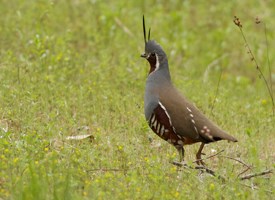B.O.T.D. Feb 27, 2015
Gray Jay (Perisoreus canadensis)
The gray jay is a bold bird, equipped for survival in the harsh North Woods. No stranger there to humankind, it has many names - camp robber, moose bird, and meat bird among them - each reflecting the bird's relationship to people and its environment. Indians call it wiskedjak, from which whiskey-jack, one of its most common names, was taken. In Algonquin-Ojibwa lore, the sly Wiskedjak is the gray jay in human form. In real life, the large chickadee lookalike both vexes and entertains. For if pilfering defines the family, the the whiskey-jack is the quintessential jay. Campers soon learn that all food is the fearless bird's prey; indeed it may boldly alight on a plate or a frying pan to filch a tasty morsel. Hunters, too know that the sound of a gun will bring the gray jay, eager for moose or deer meat. The Indians sum up by declaring that whiskey-jack will eat anything, including moccasins and fur caps.
 The bird's opportunistic behaviour is not purposeless. It is storing food and fattening itself against the long northern winter, when it may have to eat lichens for fir needles, and when its biological clock will impel it to begin nesting in late February or early March. With snow on the ground and subzero temperatures keeping it close to its eggs in a feather-lined nest, the gray jay will need secret stores, perhaps of tidbits of bacon and hash-browned potatoes as well as the berries and nuts stored away during summer's halcyon days.
The bird's opportunistic behaviour is not purposeless. It is storing food and fattening itself against the long northern winter, when it may have to eat lichens for fir needles, and when its biological clock will impel it to begin nesting in late February or early March. With snow on the ground and subzero temperatures keeping it close to its eggs in a feather-lined nest, the gray jay will need secret stores, perhaps of tidbits of bacon and hash-browned potatoes as well as the berries and nuts stored away during summer's halcyon days.














